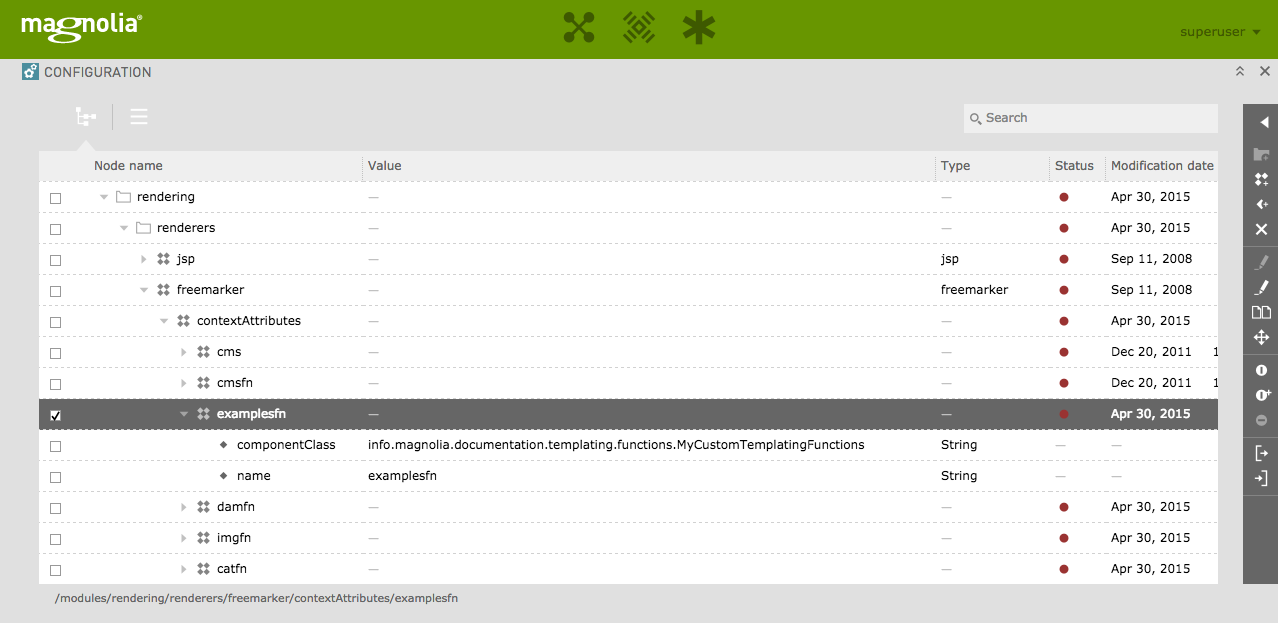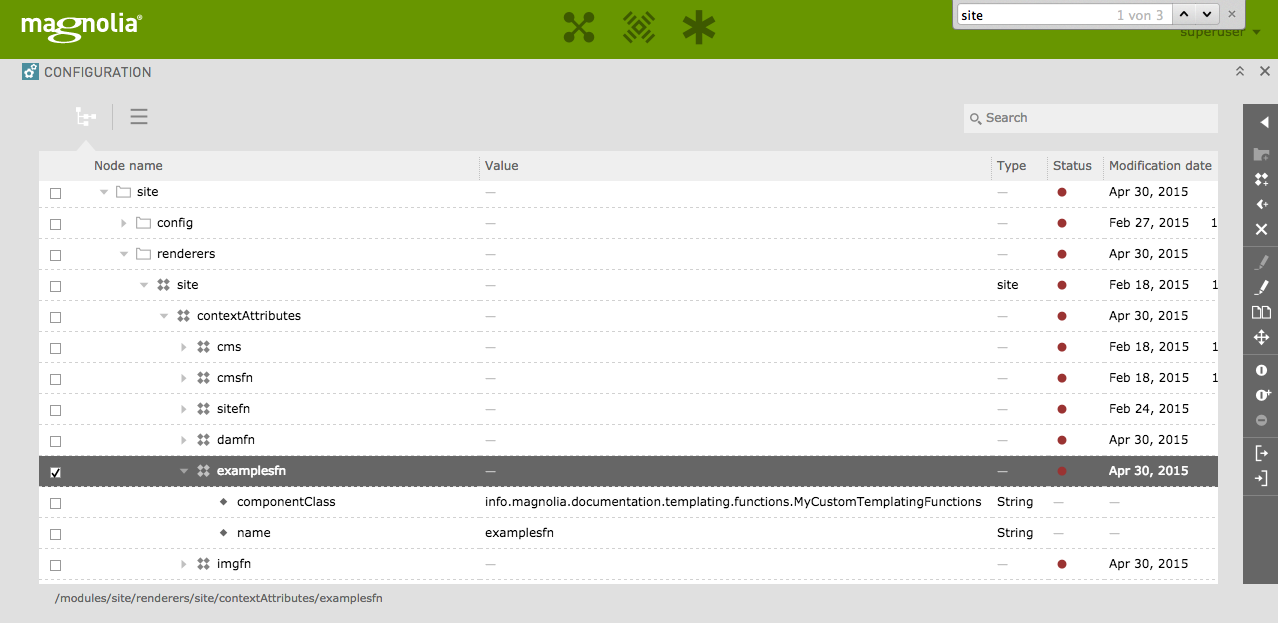Templating functions
Templating functions perform typical templating tasks such as creating links and navigating content. This page explains where you can use templating functions and how to create your own.
Function sets
Templating functions are grouped into sets according to their purpose:
| Function set | Purpose | Installed by module | Version note |
|---|---|---|---|
Navigate content and create links. |
Templating (Available in every bundle.) |
||
Get assets and renditions and create links to assets. |
DAM (Digital Asset Management) |
2.0+ |
|
Get sites and themes. |
1.0+ |
||
Create site navigation. |
MTE (Magnolia Templating Essentials) |
0.14+ |
|
Get categories (tags) and access content by category. |
2.4+ |
||
Search pages and content. |
MTE (Magnolia Templating Essentials) |
0.6+ |
|
Access REST clients. |
1.0.4+ |
||
Get links to images from any workspace. |
3.2+ |
||
Create links to css and js files by given patterns. |
2.5.1+ |
||
Generate JSON from JCR nodes of any workspace. |
|||
Search tagged content and tags. |
1.0+ |
||
Construct search queries and trigger searching in a Solr server. |
5.6+ |
|
Templating function is not available?
|
Using functions in template scripts
Use templating functions in template scripts for common tasks such as navigating content. You typically pass arguments to a function and get an object in return. You can assign the returned object to a variable to process it further.
Example: Getting a page title with the cmsfn.contentByPath function
[#assign myPage = cmsfn.contentByPath("/hello")]
<p>
${myPage.title}
</p>In this example we use the
contentByPath
function in a Freemarker script. We pass the path /hello to the
function as an argument. At the path is a page named hello. The
function returns a
ContentMap
object that represents the page node and its properties. We assign the
ContentMap to the myPage variable. ContentMap provides easy access to
a node’s properties. We use the title method to retrieve the page
title and render it on the page.
See the function sets for more examples.
Using functions in Java classes
You can also use templating functions in Java classes. This is useful when you write your own templating functions or want to use the existing functions in a model class.
Example: Injecting TemplatingFunctions into a model class and
creating a link to the site root page
public class ExampleModel<RD extends TemplateDefinition> extends RenderingModelImpl<TemplateDefinition> {
private final TemplatingFunctions templatingFunctions;
@Inject
public ExampleModel(Node content, TemplateDefinition definition, RenderingModel<?> parent, TemplatingFunctions templatingFunctions) {
super(content, definition, parent);
this.templatingFunctions = templatingFunctions;
}
public String getLinkToRootPage() throws RepositoryException {
Node rootPageNode = templatingFunctions.root(getNode());
return templatingFunctions.link(rootPageNode);
}
}Notes:
-
Line 5: Inject a
TemplatingFunctionsobject in the constructor. All Magnolia templating functions can be injected. WARNING: Never instantiate a templating function class directly. -
Lines 11-12: Use the instance in the methods.
Creating custom templating functions
To create custom templating functions:
-
Implement a templating function class. If you want to use the existing templating functions, inject them into a Java class.
-
Enable instantiation by IoC of the new custom templating functions class (see Dependency injection and inversion of control).
Implement a templating function class
This example introduces a custom function set examplesfn. It provides
a function getRandomNumber which returns a random integer.
public class MyCustomTemplatingFunctions {
public static final String examplesFunctionsName = "examplesfn";
private Random random;
public MyCustomTemplatingFunctions(){
random = new Random();
}
/**
* Returns a random Integer in the range of given min and max value.
*/
public Integer getRandomNumber(int min, int max){
int randomNum = random.nextInt((max - min) + 1) + min;
return randomNum;
}
}Configure the functions in a renderer
A renderer executes a template script and evaluates any templating functions in it. Every templating function must therefore be configured as a context attribute in the renderer.
In order to use your own templating functions with the default
info.magnolia.rendering.renderer.FreemarkerRenderer,
register the functions in the Freemarker
renderer configuration. The Freemarker renderer is configured in
/modules/rendering/renderers/freemarker.
Any module can register templating functions. Magnolia adds the functions to the Freemarker renderer configuration during module installation. When you add a module that registers functions to your webapp bundle, the functions become available to your template scripts.
Similarly, if you want to use standard Magnolia function sets such as
cmsfn in your custom renderer, register them in your renderer
configuration.
In this example, we assume the Site module is installed. We enable the
custom function class MyCustomTemplatingFunctions in both freemarker
and site renderers. Use
info.magnolia.rendering.module.setup.InstallRendererContextAttributeTask
in the module version handler class of your custom module to add the
function configuration to the renderers:
public class TemplatingExamplesModuleVersionHandler extends DefaultModuleVersionHandler {
@Override
protected List<Task> getExtraInstallTasks(InstallContext installContext) {
List<Task> extraInstallTasks = new ArrayList<Task>(super.getExtraInstallTasks(installContext));
extraInstallTasks.addAll(getFunctionsInstallerTask());
return extraInstallTasks;
}
private List<Task> getFunctionsInstallerTask() {
List<Task> tasks = new ArrayList<>();
tasks.add(new InstallRendererContextAttributeTask("rendering", "freemarker", MyCustomTemplatingFunctions.examplesFunctionsName, MyCustomTemplatingFunctions.class.getName()));
tasks.add(new InstallRendererContextAttributeTask("site", "site", MyCustomTemplatingFunctions.examplesFunctionsName, MyCustomTemplatingFunctions.class.getName()));
return tasks;
}
After module installation both renderers are configured with the custom functions.


Enable instantiation by IoC
Magnolia uses Dependency injection and inversion of control. Context attributes such as templating functions configured in a renderer are instantiated via IoC in info.magnolia.rendering.context.RenderingContext. To enable instantiation, make sure your templating function class has a public constructor and register the class as a component in a module descriptor.
<!DOCTYPE module SYSTEM "module.dtd" >
<module>
<name>documentation-templating-examples</name>
<displayName>Documentation templatingexamples</displayName>
<versionHandler>info.magnolia.documentation.templating.setup.TemplatingExamplesModuleVersionHandler</versionHandler>
<version>${project.version}</version>
<components>
<id>main</id>
<component>
<type>info.magnolia.documentation.templating.functions.MyCustomTemplatingFunctions</type>
<implementation>info.magnolia.documentation.templating.functions.MyCustomTemplatingFunctions</implementation>
<scope>singleton</scope>
</component>
</components>
<dependencies>
<dependency>
<name>rendering</name>
<version>5.4/*</version>
</dependency>
<dependency>
<name>site</name>
<version>1.0/*</version>
</dependency>
</dependencies>
</module>